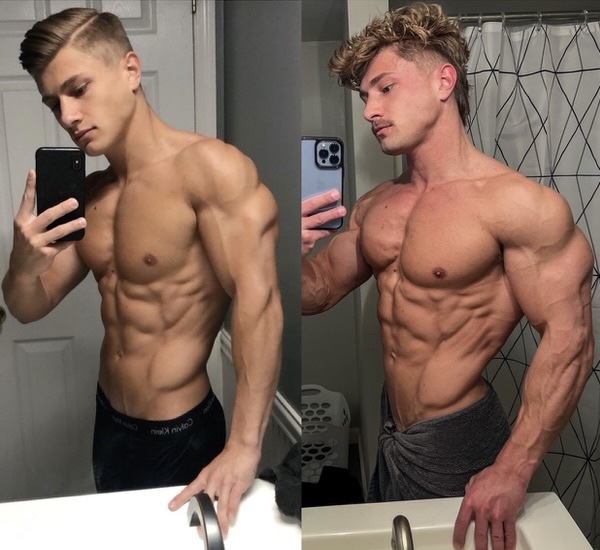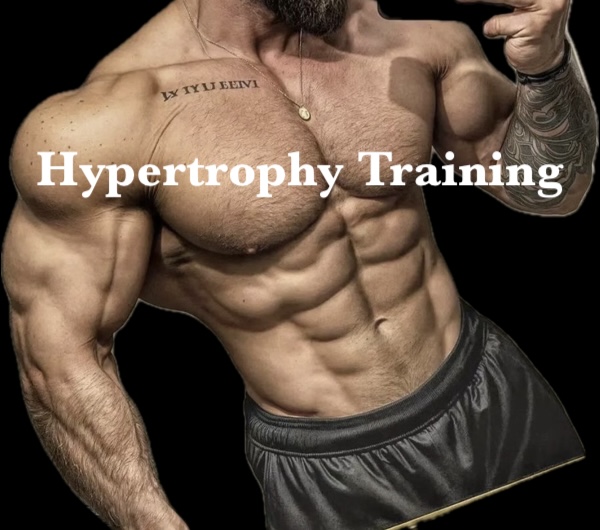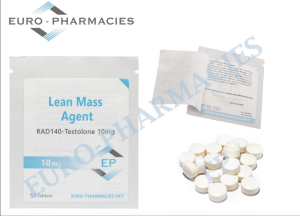You have likely heard the term “hypertrophy” before, right? Everyone in the fitness industry seems to mention it. It is all over social media, and people talk about hypertrophy in the gym every day. Some even seem to use it without fully realizing what it actually means. So, let’s check it out and fully understand what hypertrophy means.
Hypertrophy is the physiology of gains. This is the scientific term for “building muscle” as it describes the process of muscle tissue stimulation and repair. In other words, hypertrophy means muscle growth. Therefore, hypertrophy training means that you are training in a particular way that helps you build muscle.
The principle of it is relatively simple – you lift progressively heavier weights, create a calorie surplus, and get enough rest so the muscles would have time to heal, and grow bigger. This way, the body will build larger muscles (out of the calorie surplus you have) which will help cope with the increasing loads (progressive overload).
Although the principle is simple, there are a lot of details and each one of them matters a lot. You need to read on if you want to learn about some of those details and know how you can supersize your gains.
What is Hypertrophy?
Hypertrophy describes the growth of muscle cells through exercise. When you’re training (lifting weights), you’re creating tiny micro tears in the muscles. This is why you can’t lift the same weights continuously – as you lift, the micro tears accumulate, so you can lift lighter and lighter with each rep. But then, as we recover, the body repairs those minor tears. Moreover, as a way to deal with that type of stress, the muscles will grow back bigger and stronger.
The muscles are made up of fibers bound together in tissue groups. Trauma during the exercise (micro-tears) will activate the cells in those fibers, and this will trigger a response from your immune system to start repairing that damage. At this moment, your body will release various hormones such as testosterone and growth hormone as they aid the repair process.
For example, testosterone will boost the creation of protein molecules that repair those injured tissues during exercise, and growth hormone will instruct the cells to thicken the muscle fibers. This all leads to stronger and bigger muscles. And you know this process as protein synthesis. That’s why people with more testosterone and human growth hormone end up with larger and stronger muscles. These hormones aid protein synthesis which is crucial for hypertrophy.
- Alternatively, we have MK677 (Ibutamoren) for sale that boosts HGH creation and we have SARMs for sale such as RAD-140 (Testolone) and LGD-4033 (Ligandrol) that work in a similar way to testosterone which boosts the creation of protein molecules repairing the injured tissues. This is why these compounds can greatly help support your hypertrophy (muscle growth) goals!
BUY SARMS FOR HYPERTROPHY HERE
But why doesn’t all lifting result in hypertrophy?
Well, when you build strength, you focus on low reps and heavy weights. This won’t lead to enough micro tears in the muscle fibers, so not enough muscle growth. Instead, you get stronger. Yet, if you are training for endurance, you are doing low weights and higher reps. This will boost performance, but due to lighter weights, it also won’t create enough micro tears. Therefore, for optimal results in terms of muscle growth, you will need to train for hypertrophy, which is somewhere in the middle of reps and weights.
What is Hypertrophy Training?
Essentially, hypertrophy training will maximize muscle growth. It focuses on muscle growth more than on strength or endurance boost. To achieve success, you will combine compound and isolation exercises to make sure that you work multiple muscle groups from all angles, ensuring you focus on each specific muscle group at the necessary time so they will continue growing.
There are compound exercises that trigger a powerful hormone response post-resistance training. They combine multiple muscle groups at once, and they allow you to train with heavier weights. On the other hand, isolation exercises will provide a way to apply more targeted volume to a muscle, such as to the triceps or biceps.
During hypertrophy training you do not focus on heaviest weights, nor do you focus on the lightest ones. At the same time, you do not focus on a lot of reps or few reps, you aim for a hypertrophy rep range, which is anywhere between 5 and 15 reps. So, when you follow a hypertrophy training program, here’s what you should consider:
- Volume – according to research, higher training volumes will maximize anabolism. Multi-set protocols with high resistance training volumes will optimize hypertrophy training.
- Frequency – the number of times a muscle is worked per week will count too. Split routines are going to allow you to work out a muscle more often each week.
- Load – the intensity of the lift is a crucial factor when it comes to hypertrophy response. The best would be to mix up the load. Don’t mix too heavy, nor should you lift too light.
- Rest – this is another important factor for you to consider. Research suggests that you should rest for about two minutes between compound movements and about one minute for isolation moves.

Genetics Affect Hypertrophy?
Yes, your genetics does affect hypertrophy and it affects it a lot! Genetics largely affects the hypertrophy of each person as it is the primary factor that determines how much muscle you can build! So, the amount (and speed) of muscle growth is down to your genetics. But you should understand that even if you have the best genetics, you won’t achieve any results without training hard, eating well, getting high quality sleep, and managing stress. On the other hand, even if you do not have the best genetics, you will still achieve great results if you are doing all of these!
When you work out regularly and you do everything you can to make gains, you can get impatient. However, it is important to understand that even if you have great genetics, it can still take a long time to build significant muscle. Keep in mind that most physiques that you see in the bodybuilding stages require 10 years of continuous hypertrophy training to achieve such results. Muscle growth is a marathon, definitely not a sprint.
Nonetheless, it doesn’t mean that you can’t speed it up. With perfect genetics or not, you still need to train hard and keep having a great diet. Yet, with perfect genetics or not, you can speed up your training and dieting efforts with SARMS.to! As said, we have various compounds that either help mimic or boost the effects of hormones such as Testosterone or HGH which will significantly aid your hypertrophy goals.
What’s the difference between working out for strength and hypertrophy?
You need to realize that there are differences between working out for strength and hypertrophy. This explains why you may see generally smaller guys who seem to be stronger than bigger guys. While bigger muscles usually come with a strength boost, stronger doesn’t always mean bigger. You may not really be interested in this when you’re a beginner. However, the more advanced you become, the more specific you need to train for your particular goals.
- For example, if you train anywhere between six to 12 rep ranges, then you are probably training for hypertrophy. Yet, you do gain some strength too. Nonetheless, if you are a long time lifter who wants to primarily boost strength, then you should add training days with 2-5 rep ranges, lifting at about 80% of your 1RM.
You do get stronger and gain muscle in both cases, leading to numerous other benefits such as improving your overall quality of life. But each focuses on their own goal.
How to Maximize Hypertrophy Gains?
Effective hypertrophy means that you find the perfect balance between training, nutrition, and recovery. You can’t achieve hypertrophy without one of these essential factors. On the other hand, you shouldn’t have “too much” of any of these. That’s why we’re talking about a perfect balance. You need to do a perfect amount of damage to your muscle fibers when training, then get the perfect amount of calories, as well as micro and macro nutrients that force your body to repair them thicker and stronger when dieting. This entire process happens when you’re recovering and resting (mainly during high quality sleep). So, all this magic works with the proper balance of calories, nutrition, training, rest, and so on.

How to train?
You must keep challenging your muscles with progressive overload for them to continue growing. Otherwise, they adapt to the constant stress and they just don’t grow. This means that each session should increase the strain placed on the muscle from the previous week. For example, if you squatted 100 lbs for ten reps last week, then this week you either need to squat 105-110 lbs for 10 reps, or do 11 reps. This will result in more stimulus. Remember to go for hypertrophy training and target each muscle group twice a week.
What to eat?
Your body will need a lot of fuel to perform those gruesome workouts and recover from them. The body needs calories to perform in the gym and then to recover. But you need the proper amount of calories. Moreover, those calories should provide proper micro and macro nutrients to ensure your body and muscles get whatever they need to keep on progressing. You should aim to get about 400 to 500 calorie surplus a day to keep on growing. Besides, make sure that you stay hydrated. Aim for at least 30 ml up to about 40 ml of water per day per kilogram of body weight.
Rest and recovery
Rest is crucial for hypertrophy! This is the moment when the actual magic happens and you grow muscles. High quality sleep is essential for muscle growth. Besides sleeping, you need to manage stress and have a quality lifestyle. After all, you’re in the gym for a fraction of your day. It is what you do with the rest of the day that makes a huge difference.
Ultimate Full Body Hypertrophy Workout Example
Here’s an example of a hypertrophy workout that is going to grow your entire body! After you complete your warm up, follow the below exercises in order. Make sure you pay attention to the form. Go for proper weights, ensuring you do the proper amount of sets, reps, and rest for each exercise.
- Back squat – 4 sets, 6 reps, 90 seconds rest
- Barbell Romanian deadlift – 3 sets, 8 reps, 90 seconds rest
- Flat dumbbell bench press – 4 sets, 6 reps, 90 seconds rest
- Neutral grip pull up – 3 sets, AMRAP, 90 seconds rest
- Bulgarian split squat – 3 sets, 10 reps, 60 seconds rest
- Dumbbell lateral raise – 3 sets, 12-15 reps, 60 seconds rest
- Chest-supported dumbbell row – 3 sets, 15 reps, 60 seconds rest
- Lying EZ Bar Skullcrusher – 3 sets, 10-12 reps, 60 seconds rest
- Incline dumbbell curl – 3 sets, 10-12 reps, 60 seconds rest
- Seated calf raise – 3 sets, 15-20 reps, 45 seconds rest
- Hanging leg raises – 3 sets, 10-15 reps, 45 seconds rest
Grow Muscle With SARMS
Are you ready to make gains following a hypertrophy routine? Sure you are. Follow the workout plan for hypertrophy training I shared above and you will surely grow huge muscles and enhance your performance in the gym. Use the information I shared and you’ll get bigger and stronger in no time.
However, you may also go for SARMS.to in order to make sure you get the best results in no time. Our 100% real and high quality bulking SARMs will ensure you are speeding up your results, and getting over the genetic limit! As we work with the best manufacturers and offer them at the lowest prices, you are sure to save money and get the best quality products!



